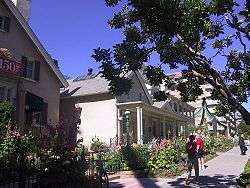Brigham Young Complex
|
Brigham Young Complex | |
 Photograph of the Lion House from the sidewalk, with the Beehive House just visible behind | |
  | |
| Location | 63-67 E. South Temple, Salt Lake City, Utah |
|---|---|
| Coordinates | 40°46′11.2″N 111°53′19.6″W / 40.769778°N 111.888778°WCoordinates: 40°46′11.2″N 111°53′19.6″W / 40.769778°N 111.888778°W |
| Area | less than one acre |
| Built | 1855 |
| Architect | Angell, Truman O.; Ward, William |
| Architectural style | Classical Revival, Late Gothic Revival |
| NRHP reference # | 66000739 |
| Significant dates | |
| Added to NRHP | October 15, 1966[1] |
| Designated NHLD | January 28, 1964[2] |
The Brigham Young Complex is a collection of buildings historically associated with early Mormon leader Brigham Young (1801-1877) on East South Temple in the center of Salt Lake City, Utah. The complex, the surviving part of a once-larger compound belonging to Young, includes the Beehive House, Young's family residence, the Lion House, his official residence as church leader and governor of the Utah Territory, and two small office buildings he used for official business. The complex is a National Historic Landmark District for its association with Young, whose leadership included the rapid expansion of Mormon settlement across the American West. The buildings are now owned by The Church of Jesus Christ of Latter-day Saints (the Mormon church); the Beehive House is open for tours, and the Lion House is operated as an event venue.
Description and history
The Brigham Young Complex is located at the southeastern corner of the enlarged Temple Square area, occupying the northwest corner of East South Temple and State Street. It is set apart from later construction by a rubble wall, portions of which were originally placed when Brigham Young designated the site in the 1850s, and portions are relocated to the area's north and west boundaries due to road widening projects. From right to left, the complex consists of the Beehive House, the President's Office, the Governor's Office, and the Lion House. The buildings are stylistically reminiscent of earlier 19th-century New England styles, with some Gothic detailing. Truman O. Angell was responsible for the design of the buildings, all of which were built in the 1850s. The right three buildings are now joined together by a modern ell in the rear.[3]
These houses were the residence of Brigham Young from 1852 until his death in 1877. As President of The Church of Jesus Christ of Latter-day Saints at the time of the Mormon settlement of the Salt Lake Valley, Young and his home were pivotal in the development of the Church, Utah, and the American west. The two houses were designated as a National Historic Landmark in 1964, and the landmark designation was later expanded to include the two office buildings.
Prior to the construction of these buildings, Young housed his family and conducted the affairs of the church and territory from log structures which no longer stand. The first of the surviving buildings to be finished was the Governor's Office, built in 1852-4. It was used by Young to house his civic administration of the Deseret Territory, later the Utah Territory. The President's Office and Beehive House were completed in 1855; the former was the seat of church business, while the Beehive House served as a ceremonial governor's mansion. The Lion House was erected in 1855-56, and was designed to house Young's large family (12 wives and 35 children).[3]
See also
References
- ↑ National Park Service (April 15, 2008). "National Register Information System". National Register of Historic Places. National Park Service.
- ↑ National Park Service. "National Historic Landmarks Program: Database of National Historic Landmarks". Retrieved March 11, 2015.
- 1 2 "NHL nomination for Brigham Young Complex (including 1987 additional documentation)". National Archive. Retrieved 2018-03-16.
External links
![]()